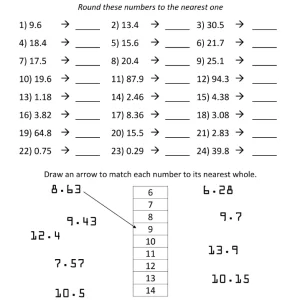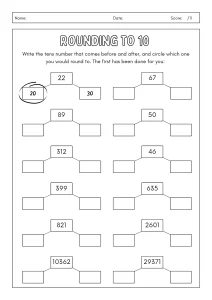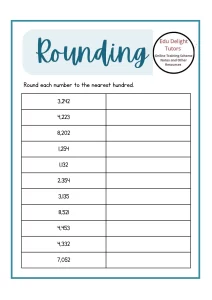Estimation and Approximation
SUBJECT: MATHEMATICS
CLASS: BASIC FIVE / PRIMARY 5
TERM : SECOND TERM
WEEK : WEEK 2
TOPIC : ESTIMATION AND APPROXIMATION
- Rounding off numbers
- Estimation sums
- Differences and products
Importance
- Manipulation and storing of data in a computer system
- Used in building blocks in logic gates
- Register and arithmetic process
- Ensuring the total cost of items at a departmental store
Learning Objectives : pupils should be able to
- Round up numbers to the nearest 10,100 and whole numbers
- Rounding numbers to the nearest tenth, hundredth, and thousandth
- Estimating sums, differences and products
- Solve quantitative Aptitude problems related with binary numbers
Learning Activities :
- Select pupils with handful of corn, rice or beans. They are then asked how many are there without counting (estimation)
- Pupils in groups study and work on a receipt of a grocery store or supermarket to practice estimation
Embedded Core Skills
- Critical thinking and problem solving skills
- Communication and Collaboration
- Leadership skills and Personal Development
Learning Resources
- Counting paper
- Number line
- Sticky notes
- Flash cards
- Eraser
- Whiteboard or blackboard
- Markers or pens
- Calculator
- Rounding worksheets
Content
Estimation and Approximation in Mathematics.
Estimation in mathematics is the process of finding a value that is approximately equal to a given number, usually by rounding. Approximation is similar, but it refers to finding a value that is close to, but not necessarily equal to, a given number. Both estimation and approximation can be used to simplify complex problems or to make rough calculations quickly.
Estimating can be considered as ‘slightly or roughly better than an educated or informed guess’. If a guess is totally random, an informed or educated guess might be a bit closer. Estimation, or approximation, should give you an answer which is broadly correct, say to the nearest 10 or 100, if you are working with bigger numbers.
How to round up numbers to the nearest 10
To round a number up to the nearest 10, you can follow these steps:
- Identify the number you want to round.
- Look at the ones digit (the digit in the ones place) of the number.
- If the ones digit is 5 or greater, add 1 to the tens digit (the digit in the tens place) to round up to the nearest 10.
- If the ones digit is less than 5, leave the tens digit as is.
- Replace all the digits to the right of the tens digit with zeroes.
For example, to round the number 37 up to the nearest 10, we would look at the ones digit (7) and see that it is greater than 5. We would then add 1 to the tens digit (3) to get 4. And replace all the digit to the right of tens digit with zeroes, so the number rounded up to 40.
To round a number to the nearest 10, look at the units digit. If the units digit is 5 or more, round up. If the units digit is 4 or less, round down.
Another example, to round the number 32 up to the nearest 10, we would look at the ones digit (2) and see that it is less than 5. We would then leave the tens digit (3) as is, and replace all the digits to the right of the tens digit with zeroes, so the number rounded up to 30


Rounding up to the nearest 10:
- To round the number 37 up to the nearest 10, we would look at the ones digit (7) and see that it is greater than 5. We would then add 1 to the tens digit (3) to get 4. And replace all the digit to the right of tens digit with zeroes, so the number rounded up to 40.
- To round the number 57 up to the nearest 10, we would look at the ones digit (7) and see that it is greater than 5. We would then add 1 to the tens digit (5) to get 6. And replace all the digit to the right of tens digit with zeroes, so the number rounded up to 60.
- To round the number 32 down to the nearest 10, we would look at the ones digit (2) and see that it is less than 5. We would then leave the tens digit (3) as is, and replace all the digits to the right of the tens digit with zeroes, so the number rounded down to 30.
- To round the number 25 down to the nearest 10, we would look at the ones digit (5) and see that it is less than 5. We would then leave the tens digit (2) as is, and replace all the digits to the right of the tens digit with zeroes, so the number rounded down to 20.
To round a number up to the nearest 100, you can follow these steps:
- Identify the number you want to round.
- Look at the last two digits (the digits in the tens and ones place) of the number.
- If the last two digits are 50 or greater, add 1 to the hundreds digit (the digit in the hundreds place) to round up to the nearest 100.
- If the last two digits are less than 50, leave the hundreds digit as is.
- Replace all the digits to the right of the hundreds digit with zeroes.
For example, to round the number 137 up to the nearest 100, we would look at the last two digits (37) and see that it is greater than 50. We would then add 1 to the hundreds digit (1) to get 2. And replace all the digit to the right of hundreds digit with zeroes, so the number rounded up to 200.
Another example, to round the number 432 down to the nearest 100, we would look at the last two digits (32) and see that it is less than 50. We would then leave the hundreds digit (4) as is, and replace all the digits to the right of the hundreds digit with zeroes, so the number rounded down to 400.
To round a number to the nearest 100, look at the tens digit. If the tens digit is 5 or more, round up. If the tens digit is 4 or less, round down.
It’s important to note that when rounding numbers you have to consider the number of decimal places you want to round to, in this case we are using the nearest 100 as an example.


Rounding up to the nearest 100:
- To round the number 137 up to the nearest 100, we would look at the last two digits (37) and see that it is less than 50. We would then round down the number , so the number rounded down to 00.
- To round the number 557 up to the nearest 100, we would look at the last two digits (57) and see that it is greater than 50. We would then add 1 to the hundreds digit (5) to get 6. And replace all the digit to the right of hundreds digit with zeroes, so the number rounded up to 600.
- To round the number 432 down to the nearest 100, we would look at the last two digits (32) and see that it is less than 50. We would then leave the hundreds digit (4) as is, and replace all the digits to the right of the hundreds digit with zeroes, so the number rounded down to 400.
- To round the number 225 down to the nearest 100, we would look at the last two digits (25) and see that it is less than 50. We would then leave the hundreds digit (2) as is, and replace all the digits to the right of the hundreds digit with zeroes, so the number rounded down to 200.
How to round up and estimate decimal numbers to the nearest tenths, hundredths and thousandths.
Rounding decimal numbers to the nearest tenths:
- To round a decimal number to the nearest tenth, you look at the digit in the hundredths place.
- If the digit in the hundredths place is 5 or greater, you round up the digit in the tenths place.
- If the digit in the hundredths place is less than 5, you leave the digit in the tenths place as is.
We can round decimals to a certain accuracy or number of decimal places. This is used to make calculation easier to do and results easier to understand, when exact values are not too important.
First, you’ll need to remember your place values:


To round a number to the nearest tenth , look at the next place value to the right (the hundredths). If it’s 44 or less, just remove all the digits to the right. If it’s 55 or greater, add 11 to the digit in the tenths place, and then remove all the digits to the right.
(In the example above, the hundredths digit is a 44 , so you would get 51.051.0 .)
To round a number to the nearest hundredth , look at the next place value to the right (the thousandths this time). Same deal: If it’s 44 or less, just remove all the digits to the right. If it’s 55 or greater, add 11 to the digit in the hundredths place, and then remove all the digits to the right.


Evaluation
What is 1856 rounded to the nearest 10?
2
What is 1856 rounded to the nearest 100?
3
What is 3.141592653 rounded to 3 decimal places?
3.141
3.142
4.252
4
What is 3.141592653 rounded to 1 decimal place?
3.1
3.0
3.2
5
What is 467 rounded to one significant figure?
400
500
470
6
What is 0.53 rounded to one significant figure?
1
1.5
0.5
7
Estimate the value of 47 × 84.
4,000
3,948
3,900
8
Estimate the value of (9 × 11) ÷ (2.57 + 2.09).
21.24
21
20
Q 1 – Round 0.1278 to the nearest thousandth A – 0.128 B – 0.126 C – 0.127 D – 0.129
Q 2 – Round 7.1093 to the nearest hundredth A – 7.10 B – 7.11 C – 7.19 D – 7.13
Q 3 – Round 4.5236 to the nearest thousandth
A – 4.524
B – 4.523
C – 4.525
D – 4.526
Q 5 – Round 42.859 to the nearest tenth
A – 42.9
B – 42.8
C – 42.7
D – 42.6
Q 6 – Round 0.0047 to the nearest hundredth
A – 0.00
B – 0.01
C – 0.02
D – 0.03
Q 7 – Round 12.009 to the nearest tenth
A – 12.0
B – 12.1
C – 12.2
D – 12.3
Q 8 – Round 12.5 to the nearest whole number
A – 13
B – 12
C – 11
D – 14
Q 9 – Round 9.8 to the nearest whole number
A – 10
B – 9
C – 8
D – 11
Q 10 – Round 8.664 to the nearest hundredth
A – 8.66
B – 8.67
C – 8.65
D – 8.68
Lesson Presentation
The lesson is presented step by step
Step 1:
- Begin the lesson by reviewing the place value chart, and the concept of rounding.
- Explain the importance of rounding and estimation in real-life situations.
- Provide examples of how rounding and estimation are used in math and other subjects.
Step 2:
- Begin the lesson by reviewing the place value chart, and the concept of rounding.
- Explain the importance of rounding and estimation in real-life situations.
- Provide examples of how rounding and estimation are used in math and other subjects.
- Introduce the steps for rounding decimal numbers to the nearest tenths, hundredths, and thousandths.
- Provide examples of decimal numbers that need to be rounded up and down.
- Have students practice rounding decimal numbers using worksheets or online resources.
Step 3:
- Have students work in pairs or small groups to round and estimate decimal numbers to the nearest tenths, hundredths, and thousandths.
- Monitor students’ progress and provide feedback.
- Have students share their work with the class and discuss any challenges they encountered.
Step 4:
- Provide students with a set of decimal numbers that need to be rounded and estimated to the nearest tenths, hundredths, and thousandths.
- Have students work independently to complete the task.
- Collect the students’ work and provide feedback.
Conclusion :
- Review the key concepts covered in the lesson.
- Provide examples of how rounding and estimation can be used in real-life situations.
- Assign homework or additional practice problems related to rounding and estimation.
Assessment:
- Formative assessment can be done through observation of student’s participation in the class discussion and their performance on worksheets and practice problems.
- Summative assessment can be done through a quiz or test that includes questions on rounding and estimating decimal numbers to the nearest tenths, hundredths, and thousandths.